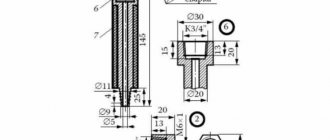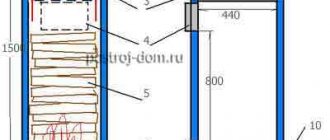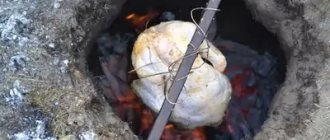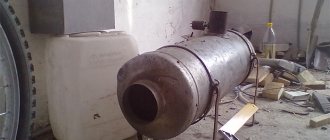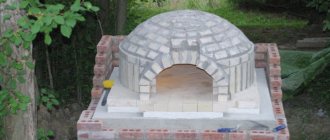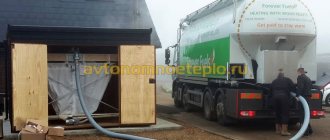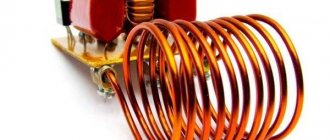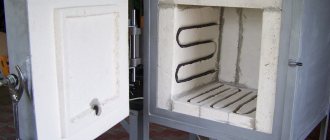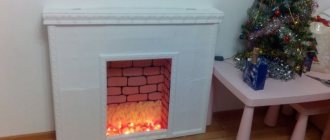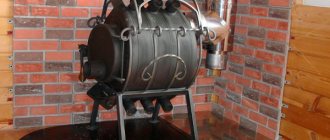Home / Burners for boilers
Back
Published: 06/25/2020
Reading time: 5 min
0
1891
A pellet burner is a modern energy-efficient device designed to use a special fuel for solid fuel boilers - pellets.
The main advantages of this type of boiler equipment are considered to be the high efficiency of the heating unit due to the complete combustion of pellets and the possibility of 100% automation of the combustion process using innovative diagnostic and control tools.
Modern household welding and plumbing tools allow the home craftsman to make a pellet burner with his own hands.
- 1 Design and principle of operation of a pellet burner 1.1 Gravity burners
- 2.1 Creating a drawing of a pellet burner with dimensions
Types of pellet burners
Despite the common structure, pellet burners differ in the method of fuel supply and design features (flare and retort).
According to the method of fuel supply, burners with forced and gravity feed are distinguished. In the latter, the hopper is mounted directly above the burner, and the fuel is simply poured onto it under the influence of gravity. This design is quite simple, but does not make it possible to regulate the rate of fuel flow.
Forced-feed burners, on the other hand, are well controlled. Allows you to dose pellets in accordance with the current combustion mode. A pneumatic lift or auger mechanism is used.
With pneumatic supply, fuel is dosed by a metering device installed in the hopper. Then it is directed through the supply pipe to the burner. In this case, the possibility of reverse combustion (and, as a consequence, fuel ignition in the fuel tank) is excluded, since there is no continuous flow of pellets in the supply pipe. In addition, the air blows from the direction of the bunker, that is, towards the possible path of the fire.
In systems with auger feeding, two units are used: an auger that lifts pellets in the hopper and pushes them into the feed pipe, and an auger that feeds them into the combustion zone. At the same time, the risk of fire entering the bunker cannot be excluded, since there is a continuous flow of pellets through which the fire can spread to the fuel storage tank. To avoid this, the supply pipe is made of low-melting material. It melts in a matter of seconds and interrupts the path of fire into the bunker, guaranteeing a fairly high level of fire safety.
The design of a pellet burner, be it a torch or a retort, may differ from one manufacturer to another, although not significantly
Therefore, it is worth paying attention not only to the price, but also to what determines this price. In any case, inexpensive pellet burners are a utopia, because this equipment often costs more than a solid fuel boiler. Essentially, a boiler is simply reliably welded sheets of metal within which water circulates
The burner design is much more complex, especially the flare burner
Essentially, a boiler is simply reliably welded sheets of metal within which water circulates. The burner design is much more complex, especially the flare burner.
Pellet burner device
What does the burner consist of?
Pellet burners are usually equipped with a fuel supply screw, a controller that automatically regulates the operation process, and a hopper - a container in which pellets are located; lambda probe - a device that measures the remaining oxygen in flue gases and automatically regulates the combustion process.
A plastic corrugated pipe can be installed between the burner and the auger, which, if backdraft occurs and the fire moves towards the bunker, burns out and the fire does not spread further.
In addition, the pellet burner is directly equipped with an air supply fan and a thermoelectric heater for automatic ignition of the pellets.
Pellets as fuel
Pellet is a fairly energy-intensive fuel: 1 kg of it produces approx. 5 kW/h heat. Those. To heat a medium-sized house in mid-latitudes, the burner should burn approx. 2 kg pellets per hour; In terms of volume, it’s about half a bucket. You need to add pellets to the bunker (see below) 1-2 times a day and at the same time empty the ash pan of the boiler; the ash is quite suitable for fertilizer. A good branded burner should be cleaned no more than once a week (those requiring cleaning once a season cost from $5,000); homemade will have to be cleaned every 3-4 days.
But, firstly, pellets burn well and just like that, although they produce a lot of ash. The problem with all existing pellet burners without exception is the possibility of the so-called. reverse combustion, when the pyrolysis zone penetrates the fuel bunker, and then - smoke, stench (poisonous), fire. Secondly, pellet burners are critical to the air supply: if there is too much air, the pellets can be blown off the burner and produce a lot of ash; little - again a lot of ash and coking. The air requirement of the burning mass of pellets depends quite strongly on the combustion mode. As a result, it is not so easy to set the correct combustion mode for pellets. In general, a pellet burner is ignited in stages: way:
- Ignition is carried out with a special lighter, which is a ceramic rod heated to 900-1100 degrees. A homemade burner can be lit with a torch, but in no case should it be flammable! The combustion will immediately jump into the bunker!
- Starting - the air supply is adjusted (see below) until a stable flame is formed;
- Acceleration (reaching operating mode) - also using air (possibly together with the fuel supply) to achieve a smokeless flame (possibly with control of its temperature) and blowing off ash from the burner without blowing out the pellets;
- Operation in standby mode - the air is covered until the specified temperature of the coolant in the return is achieved;
- Stop - the fuel supply is cut off, and air is supplied according to step 3 until the remainder is completely burned.
Installation of a pellet burner Obshchemmash VS 4/35 in a solid fuel boiler
Sooner or later, any owner of a solid fuel boiler (coal, wood or briquettes) faces one problem. He just gets tired of drowning this gluttonous unit. Moreover, if in the off-season it is enough to do this once a day, then in cold weather you need to add fuel two, three, or even four times a day! What if you need to leave for a few days?!
But there is a simple and beautiful way out! In almost every solid fuel boiler you can install a pellet burner without major modifications and enjoy all the benefits of automatic heating. Yes, exactly automatic! The boiler will light itself up and go out as needed, add fuel on its own and monitor its temperature.
An example is a small car service in Karelia, where historically there was a 50 kW Viadrus solid fuel boiler with a heat accumulator.
The massive cast-iron Viadrus was actively used and was quite capable of heating the complex. The presence of a heat accumulator made it possible to smooth out its excess power for this area. The only nuance caused inconvenience to the owners and visitors - the car service workers regularly forgot to add firewood until it became too cold.
Therefore, it was decided to install a BC 4/35 pellet burner produced by Obshchemmash into the existing boiler. The burner has a mechanical self-cleaning grate, which allows the use of low-quality fuel pellets. As a nice bonus, the burner has a built-in GSM module, with which you can control the boiler via SMS, and a Wi-Fi module - you can monitor it from a computer or tablet. The burner comes complete with a hopper and a fuel feed auger.
The main difficulty during installation was the discrepancy between the sizes of the burner nozzle and the boiler furnace. It is impossible to saw off or sharpen the “excess” in the boiler, since in Viadrus this “extra” is filled with water. Therefore, we decided to move the burner outside by 5 cm using a simple welded structure made from corners.
The main modification was made to the front door of the boiler, in which a hole was cut with a grinder for the mounting flange that comes with the burner, holes were drilled for the mounting bolts, and a structure of metal corners was welded on.
After installing the burner, the door opens freely and does not interfere or touch anything. By the way, to turn the boiler from a pellet one back into a solid fuel one, you need to unscrew the two screws and put on the lid that comes with it. All.
All that remains is to pour pellets into the bunker and press “Start”.
Device
A pellet boiler consists of a burner, a hopper and a screw mechanism used to supply fuel.
Burner
It can have different designs, which determine its technical characteristics and operating principle.
The volumetric one is installed directly into the firebox of the device. It can be steel or cast iron. Manual (using matches) and automatic ignition is allowed. In the latter case, a special electric fan is provided.
Screw mechanism
The mechanism is powered by an electric motor. It has an auger up to two meters long. Geometric parameters within the specified limits avoid the need to clean out sawdust, which often accumulates at the point of pellet supply.
It can be equipped with a special sensor that controls the degree of heating of the auger casing. When overheating, the fuel supply stops due to the automatic operation.
Bunker
The design features of the bunker have a direct impact on the duration of operation in autonomous mode. For longer work, an additional auger is often installed. Sometimes a package of pellets, secured using special stands, acts as a bunker.
Such a system not only allows for timely supply of fuel, but also solves the problem of its storage.
Gravity pellet burner: design features
Devices of this type, operating on pellet fuel, have a different operating principle for supplying pellets. It should be said right away that such units are more convenient to use. The main advantage of the gravitational mechanism is that it does not require a connection to the electrical network.
In this case, the pellets are located in a bunker and can enter the connected channel under the influence of their own weight. There are several popular domestic companies producing such units (Pelletron, Behemoth). A pellet burner of this type is started very simply - by changing the position of the damper. It is important to remember that the chimney has a draft regulator, which can also be adjusted.
On a note! The main disadvantage of all gravity structures is that they do not provide as much safety during operation as their counterparts. During operation, there is a possibility of ignition of granulated fuel in the bunker. An increased risk of ignition exists due to the design of the hopper, which is directly connected to the opening through which the fuel is supplied.
Gravity pellet burners can be used without an electrical connection.
The efficiency of gravitational devices is slightly lower than that of analogues that operate through the forced supply of granular fuel. Installing this type of pellet burner is not a difficult task. Its complete connection can be completed in just a few hours.
In order to increase the fire safety performance of this device, many manufacturers install special dampers on it. They are equipped with thermal sensors, which, if a flame enters the channel connecting to the bunker, are activated and block the passage.
How to choose?
From the very beginning, it is worth considering that when choosing pellet burners for a stove or boiler, retort models will have to be considered last. Their efficiency, even for the best samples, does not exceed 76%. If just one node fails, the system completely loses its functionality. Only when replacing the problematic unit will it start again.
The rating of the best samples confidently includes Pelltech PV 20-180. This system uses a standard Euroflange, which allows the device to be installed in pressurized budget boilers or boilers designed for biofuel. Heat-resistant steel is usually used to produce the firebox and grate.
In more advanced models, the combustion chamber is formed from ceramic stones. The tubular design of the firebox and the addition of a screw allows for more efficient combustion. Any Pelltech modification is designed for 7-9 levels of work intensity. Power can be assigned manually or in modulation mode.
Also worth noting:
- presence of pellet level sensors;
- automatic ignition;
- display on the control panel;
- pneumatic or mechanical cleaning circuit;
- storing a “message log” in the automatic device’s memory.
The OXI Ceramik+50 pellet burner is definitely worth mentioning. This device is equipped with movable grate bars with self-cleaning and is installed in any solid fuel boilers. A modulation system is provided. The monoblock design has repeatedly proven itself in practice under the most difficult conditions. The important features of this model are:
- damping function;
- automatic backdraft protection system;
- input for connecting a room thermostat;
- Possibility of connecting heating pumps, smoke exhausters, pumps and thermal sensors of hot water boilers;
- Suitable for boilers up to 70 kW.
The manufacturer indicates that installation should be carried out in the boiler door
It is equally important to note that this model should only be installed by certified personnel. The delivery set includes:
- corrugated pipeline;
- auger 1.5 or 2 m long;
- 2 kOhm temperature sensor (1 for boiler, 1 for feeder);
- technical certificate;
- installation and application manual;
- warranty card.
When choosing systems with a flare burner, it is necessary to take into account the difference between models that go into stop mode after heating the boiler, and those that are designed for modulation, that is, maintaining a given temperature level. Retort systems are mainly suitable for cases where automatic ignition is not very important. In passive mode, they do not go out completely, but begin to smolder.
You should definitely pay attention to the screws. The stability of the entire system depends on the quality of these screw spirals. Retort burner units are usually equipped with axial screws
They can handle pellets of any length and any sawdust concentration. Axleless types of augers, typical for flare burners, are much more reliable; they create significantly less load on the drive gearboxes
Retort burner units are usually equipped with axial screws. They can handle pellets of any length and any sawdust concentration. Axleless types of augers, typical for flare burners, are much more reliable; they create significantly less load on the drive gearboxes.
The pellets in some retort boilers are fed by two augers; other models use a valve. If designers have chosen a single-screw feed, the hopper must be sealed to eliminate the risk of fire. The auger must also be protected from the penetration of foreign objects. Flare structures rarely provide such protection.
Device
Any burner has one goal - creating a powerful flame to heat the air or water jacket of the boiler. At the same time, the combustion power itself can be adjusted independently.
A pellet burner has similar goals. The device is a wind tunnel into which solid fuel is supplied and air is pumped for combustion. Fuel is supplied to the pipe using a special screw-type conveyor. The fuel itself is located in the loading hopper before combustion. The bunker can have a different volume, and it depends on the volume how long the burner can burn on its own without human intervention (adding fuel).
Pellet burner structure: 1 - The pellet enters the burner under the influence of gravity; 2 - Air enters the burner due to the vacuum created by the draft of the chimney; 3 - Pellet combustion occurs in the combustion chamber, which is called the “basket”; 4 - Due to the high temperature, thermal decomposition of wood occurs in the basket, which forms a flow of flammable gases; 5 - A secondary air flow passes under the basket; 6 - In the burner nozzle, the flow of combustible gases and secondary air mixes, forming a torch; 7 - Solid combustion products are ejected from the burner into the ash pan of the boiler or furnace by a stream of secondary air; 8 - Ventilation of the supply channel does not allow hot gases to diffuse up the channel and destroy the pellets, ensuring a stable supply of pellets.
Air is forced into the combustion zone by means of a fan.
The combustion chamber in the burner can be round or rectangular. Round burners are the most common due to their ease of manufacture. A pipe connection is attached to the outside of the combustion chamber, through which fuel is supplied from the conveyor.
The design also includes an ash pit in which combustion waste accumulates. During the combustion of pellets, a little ash is formed, so you need to clean the ash pan no more than once a week when the burner is actively used.
There are several types of pellet burners, each of which has its own advantages and disadvantages.
Flare type
Initially, the device was used to generate heat by burning grain, but later it was converted to burn solid compressed fuel.
Side view of a flare type burner
- Small overall dimensions;
- Can be used in conjunction with boilers with a small combustion chamber;
- Simplified operation;
- Increased reliability;
- You can burn low quality pellets.
- Low power compared to other burners;
- The flame is directed horizontally, which is why it heats the boiler locally.
Volumetric type
Unlike the previous model, they have increased power and high efficiency. The disadvantages of the device include a complicated design, large overall dimensions, and dependence on the quality of the pellets used.
General view of the volumetric combustion burner
Fireplace
Burning pellets in a fireplace burner
Such designs are mainly used in domestic conditions, installed in fireplaces and boilers. The operating principle of the device is as follows: pellets fall into a special bowl, where they are burned under the influence of air supplied from below.
The disadvantages of the model include the size of the device and the need for precise adjustments for proper combustion.
Pellet burners - purpose and operating principle
Boilers with pellet burners, an alternative to gas ones, are based on the operating principle of burning wood waste - pellets made using a special technology or using dry grain. Their purpose is to heat rooms using fuel made from wood waste. As in gas boilers, the heating process is fully automated - it takes place without human intervention. The controller regulates the supply of fuel from the hopper to the auger. Often a corrugated pipe is installed between the auger and the pellet burner for fire safety purposes. When backdraft occurs, it prevents the fire from spreading to the pellet hopper.
The pellet burner is equipped with:
- Fan for air supply - it is dosed using a controller
- Thermoelectric heater for automatic ignition of the boiler.
Thanks to this equipment, the boiler can safely operate in autonomous mode for up to seven days. It is very convenient for those who come to a country house only for the weekend - you will be greeted by a warm, cozy home. You just need to adjust the speed of feeding pellets into the boiler before leaving home. Then the “smart automation” works independently.
READ ALSO: What does your house smell like? Improves mixture odors and design
Types of pellet burners
To heat a house and heat water, several types of burners are used, which are installed in pellet boilers:
- Torch burner. The ancestor of more modern high-power burners. Initially used for burning grain and low quality pellets. Compact, simple design that is easily installed in small solid fuel boilers. The disadvantage is its low power, so it is used for heating small rooms.
- Stokernaya. For volumetric combustion. The most common type due to its high efficiency. Demanding on the quality of pellets. Large size and complex design. During installation, the correct angle of inclination is selected. An incorrect angle leads to an increase in ash content and stopping the fuel feed auger. The installation of such burners should be trusted to a specialist and preventive measures should be taken.
- Fireplace burner. It is made in the form of a bowl where fuel combustion occurs. Air is supplied from the bottom of the bowl. Installed in fireplaces and some types of solid fuel boilers.
READ ALSO: Review of solid fuel boiler Demrad
Attention! The boiler should be cleaned of combustion products at least once a month. Ash, as an excellent fertilizer, can be used in the garden.
Sponsor of the article in Ukraine: pellet-burners.com.ua/
Useful material: Warm house - heating with wood, gas, electricity, diesel fuel, tariffs and how much it costs. Subscribe.
DIY pellet burner: varieties
Devices that are used for processing granular raw materials are divided into two types depending on the principle of operation - with forced intake and gravitational. The choice of one type of equipment or another depends primarily on individual operating conditions.
At the moment, pneumatic pellet burners from Obshchemmash are popular
Devices of this type include several mechanisms through which granules are delivered. The first of them operates using a pneumatic system. The second mechanism is equipped with a special tool - a screw. Safety in the system is ensured by the design of the channel, installed from the bottom up, through which the granules are supplied.
Automatic devices have one serious advantage - fire safety. Such devices are used in equipment from different manufacturers. For example, they are integrated into Teplodar boilers. Pellet burners, reviews of which are mostly positive, are quite expensive. The price of some models exceeds 150 thousand rubles. More budget options can be purchased for 60-80 thousand rubles.
The pneumatic type design is characterized by maximum safety. This is because the pellet delivery system delivers fuel in small portions. Thus, it is not delayed in the communication channel. For such a burner, it is possible to install a large hopper that does not require frequent loading. If desired, a device of this type can be purchased. Currently, pneumatic pellet burners from Obshchemmash are very popular.
Screw-type feed mechanisms include two main units. Using the first auger, granulated fuel is taken from the bunker. The operation of this device allows you to transport pellets to another receiver. After this, the second screw sends the raw material directly to the burner.
Automatic pellet burners are characterized by high fire safety
The disadvantage of devices in which fuel supply is forced is their dependence on energy. In the event of a power outage, the burner stops operating.
Gravity pellet burner: design features
Devices of this type, operating on pellet fuel, have a different operating principle for supplying pellets. It should be said right away that such units are more convenient to use. The main advantage of the gravitational mechanism is that it does not require a connection to the electrical network.
In this case, the pellets are located in a bunker and can enter the connected channel under the influence of their own weight. There are several popular domestic companies producing such units (Pelletron, Behemoth). A pellet burner of this type is started very simply - by changing the position of the damper
It is important to remember that there is a draft regulator installed on the chimney, which can also be adjusted
Gravity pellet burners can be used without an electrical connection
The efficiency of gravitational devices is slightly lower than that of analogues that operate through the forced supply of granular fuel. Installing this type of pellet burner is not a difficult task. Its complete connection can be completed in just a few hours.
In order to increase the fire safety performance of this device, many manufacturers install special dampers on it. They are equipped with thermal sensors, which, if a flame enters the channel connecting to the bunker, are activated and block the passage.
Operating principle of pellet burners
How does a solid fuel burner work?
Pellets are fed into the firebox automatically using an auger, and the pellet supply process is regulated by a controller, to which room air temperature sensors, water sensors in the hot water and heating systems, as well as other indicators can be connected, thanks to which one or another operating mode is selected.
When the temperature reaches the required value, the controller switches the burner to standby mode. In this case, the pellets do not go out, but slowly smolder . As soon as the temperature in the heating system drops below the set value, the burner fan turns on based on a signal from the sensor, the pellets flare up and the burner goes into operating mode. If the pellets have already gone out, the ignition procedure with the heating element starts automatically.
How to make a pellet burner with your own hands
In addition to firewood and coal, there are other types of solid fuels available to many homeowners. These are wood pellets, sawdust, seed husks, grain processing waste. Due to their granular structure, burning such fuel in the classical way is inconvenient and ineffective.
You can get more heat and automate the process by installing a special burner device on the boiler. The latter are commercially available, but they are adapted to work on pellets.
To burn husks and small sawdust, you will need an additional device; one solution is a homemade pellet burner.
DIY pellet burner
The structure of the product and the purpose of its elements
The task of any burner device is to create a powerful, even flame to heat the water jacket of the boiler, the intensity of which can be adjusted.
In this regard, the pellet burner design serves the same purpose and consists of a small combustion chamber in the form of a wind tunnel into which fuel is supplied and air is pumped.
A screw conveyor is used to feed granules or husks, and fuel enters it from a loading hopper. The volume of the latter determines the duration of the installation. Air is forced into the combustion zone from a fan - supercharger.
Screw conveyor
The combustion chamber can be either rectangular or circular in cross-section. The latter is more common because it is easier to manufacture.
If we look at the design drawings of a pellet burner, then a flat tray for burning fuel must be installed in a round chamber, and it itself is attached to a flange plate, which is adjacent to the frontal plane of the boiler from the outside.
The outer part of the device consists of a screw conveyor with an upper inlet through which fuel from the bunker enters. The second element is a fan installed under the auger and supplying air to the lower part of the chamber.
Pellet burner mechanism
Bulk solid fuels after combustion produce very little waste in the form of fugitive ash, so the design of the pellet burner provides for its self-cleaning from the air flow supplied by the blower. As a result, all the ash accumulates in the ash pan, which needs to be cleaned no more than once a week.
Description of operating modes
The very principle of operation of a pellet burner is as follows: a portion of fuel enters the chamber, it is ignited and the minimum air supply is turned on. As the fuel burns and the chamber warms up, more air is forced in. As a result, a stable, even flame appears, heating the heat exchanger with water.
In factory burner devices, the process is fully automated, ignition is provided by an electric incandescent element, and its operation is controlled by a photosensor. The amount of air and pellets supplied to the chamber is regulated by an electronic unit, receiving signals from temperature and pressure sensors.
A diagram of a pellet burner will help you understand how the device works.
https://www.youtube.com/watch?v=pkvWhUl1Nws
Fuel in the form of wood pellets or seed husks can be supplied to the pellet burner auger in various ways:
- The traditional method is to supply pellets from a separate large hopper so that its capacity is enough for at least 7 days of operation of the boiler, which needs to be cleaned once a week. From the bunker, the fuel is moved to the burner device by an additional screw conveyor of the required length.
- A DIY gravity pellet burner can be equipped with a simpler fuel supply. In it, husks and granules are poured under their own weight into an auger from a hopper installed directly above the burner device, which delivers the required amount into the combustion chamber. Then the power reserve of the boiler will be from 1 to 3 days, depending on the intensity of work.
It is not difficult to select materials for making the device. Considering the temperature regime of the combustion chamber, it is better to take a pipe made of heat-resistant steel with a wall thickness of at least 4 mm. The flange plate, with which a homemade pellet burner is attached to the body of the boiler installation, can be made of ordinary quality steel with a thickness of 3 mm.
The feed conveyor can be purchased assembled, or you can make it yourself from an ordinary pipe by placing a screw in it. For rotation, a low-speed electric motor, gearbox and bearings are selected. The fan must be purchased and fixed to the plate, preparing a seat for it.
The plate itself must be made by studying the drawings of the pellet burner, and depending on the design of the boiler door.
Pellet burner parts
What's good about this choice?
One of the biggest benefits of upgrading boiler equipment is cost. Buying a pellet burner and installing it in an existing solid fuel boiler will be much cheaper than replacing the entire device. The difference can be manifold, especially in the case of modern devices, because you will have to carry out a full cycle of dismantling and installation, setting up a new installation, and also spend money on recycling the old equipment.
Other advantages of choosing a pellet burner instead of replacing equipment:
- The ability to use a fuel bunker ensures long-term autonomous operation without human intervention.
- There is a rare need for preventive maintenance: cleaning the burner is required no more than once a day, and you only need to get rid of ash once a week.
- The modernization work will take from 15 to 30 minutes, depending on the complexity of the equipment and the technical savvy of the person replacing the burner.
- Economical fuel consumption. Pellets are extremely cheap, and in agriculture and some industries they can be replaced with dry organic production waste, which will be absolutely free.
- Environmentally friendly. Compared to firewood and coal, pellets emit significantly fewer harmful substances when burned.
The pellet burner can work with various types of boilers, as well as metal and brick stoves. During furnace operation, burner devices soften the operating mode of furnaces, which has a positive effect on the durability of the latter.
Pellet burner - a new stage in the life of a solid fuel boiler
3264 2448 Pellet burner - a new stage in the life of a solid fuel boiler
Burner electronics.
As I already wrote, all electronics are powered by a separate power supply. Therefore, all burner control circuits are isolated from CPU signals by optocouplers. . Source wiring to be adjusted The upper part of the circuit is the flame sensor. A photoresistor is used as a sensor (I will indicate the brand later). The lower part of the diagram is the control of the boost turbine. Control is carried out by two low level signals. If both inputs are ones, then the turbine is turned off. When a low level (compared to +12 CPU) is applied to the “low speed” input, the full supply voltage is supplied to the turbine through a field-effect transistor. This mode is used when purging combustion residues in the burner before the next loading and ignition.
Advantages and disadvantages
The equipment has a number of advantages:
- Pellets are a safe fuel compared to gas and electricity;
- Allows you to significantly reduce space heating costs compared to using electric boilers. At the same time, pellet installations are more expensive than gas equipment, but do not forget that it is not always possible to supply gas and purchase gas cylinders;
- Homemade installations guarantee high efficiency - 95%. Some store installations are over 97%;
- They are used not only for heating the room, but also for producing hot water;
- There are no rules for transporting and storing fuel. When near a person, pellets do not cause allergic reactions, and there are no toxic fumes when burning;
- Fuel is available for purchase. Equipment owners complained about the lack of fuel and the need to prepare a supply of pellets from the winter when the devices appeared; now there is no need to store a large volume of pellets at home; if necessary, they can be bought everywhere;
- The price of pellets is on average at the same level, unlike gas and electricity, the tariffs for which periodically experience seasonal fluctuations;
- Installation of the device does not require special skills, and there is no need to coordinate the installation with authorized bodies;
- After combustion of pellets, natural mineral ash is formed, which does not require special rules for disposal.
Along with the advantages of such equipment, there are also a number of disadvantages:
- High cost of ready-made store equipment. Despite the popularization of devices in recent years and some reduction in prices, pellet boilers are still more expensive than gas or electric equipment of similar power;
- The equipment requires constant maintenance (especially outdated models). The user will have to clean the ash pan and heat exchanger from accumulated ash once a week. In modern models, cleaning is provided at an automatic level;
- In the absence of automatic fuel supply, the user has to load pellets into the bunker manually;
- It is necessary to ensure minimum humidity conditions in the rooms in which pellets will be stored awaiting use;
- Imported equipment is practically not designed for the conditions of the harsh domestic winter, as a result of which breakdowns and malfunctions often occur;
- In remote areas, fuel for the winter still has to be stored due to the instability of supplies.
Making a pellet burner
Pellet installations are often ignored by buyers because of their high cost compared to gas and electric equipment, and the problem is solved by making the device at home.
The combustion chamber can be constructed from a square or round pipe. It is better to give preference to heat-resistant steel that can withstand elevated temperatures; the wall thickness should be at least 4 mm.
The home-made installation is fastened to the boiler using a flange plate made of heat-resistant steel with a thickness of 3 mm.
A container for supplying fuel to the combustion chamber can be purchased or made by yourself. The best option is to immediately make an installation in which fuel will be supplied automatically. To do this, place an auger in the purchased pipe of the required diameter. The rotation of the device will be carried out by a bearing, gearbox and motor operating at low speeds.
Additionally, the store can purchase a fan that will pump air. The fan is mounted on a plate, which is made depending on the size and door design of the boiler used in your home.
It is also important to take care of adjusting the amount of incoming fuel and the volume of air pumped by the fan, otherwise the homemade device will work unstably. In home devices, the air supply force and the number of pellets are adjusted manually. This method is inconvenient due to the fact that it requires constant supervision of the burner.
This method is inconvenient because it requires constant supervision of the burner.
For automation, an electrical incandescent element and a photosensor are purchased. The first device ignites the flame if the pellets go out and also regulates the switching on of the device. The photo sensor monitors the appearance of the flame: if the flame is stable, the sensor transmits a signal to the glow element to stop ignition.
To automate the system, a filling sensor is also purchased. It will notify the electronics of the device about the degree of filling of the combustion chamber with pellets.
Pellet burners are modern equipment for boilers, which can improve the environmental friendliness of the process and reduce fuel costs. At the same time, the equipment in the store itself is expensive. For basic household needs, it is better to give preference to homemade devices, the operation of which can be automated if necessary.
Design and principle of operation of pellet boilers
To install such a solid fuel installation yourself, you will need to work hard, and first understand how it works and what it consists of. The heart of the pellet unit is the burner device, which performs almost all the main functions and is connected to the boiler controller, acting on its commands. Burners designed for burning pellets are of two types:
- retort;
- flare
The difference between them is as follows. A retort pellet burner is a bowl (retort) filled with fuel from below via a screw, and air is supplied to the combustion zone by a fan through holes located on the sides of the bowl. During operation, the flame column is directed upward, which must be taken into account by the design of the boiler. The flare burner device is a pipe, which is also the combustion chamber, where a screw feed of pellets occurs at one end, and a powerful flame torch, directed horizontally, comes out of the other. This is achieved by forcing air into the chamber from the same side as the fuel.
In the future, we will consider the operation of the unit with a torch burner, since this design is better suited for our purpose. So, the combustion chamber in the form of a pipe is located inside the boiler, and the outer part of the burner consists of a housing with a feed screw and a fan for forcing air. To operate the electric ignition and maintain the flame, the design also includes a control board, a photosensor and an incandescent element. At the top of the housing there is a fuel supply pipe.
The process goes like this: at the controller’s command, the auger delivers a small amount of pellets into the chamber and stops. The glow element turns on and at the same time the fan turns on, causing the fuel to ignite. The appearance of a stable flame is detected by a photosensor and notifies the control unit, which turns off the incandescent element. Then work begins in normal mode, the screw conveyor resumes supply, and the fan pumps in the required amount of air. At the command of the same controller, pellets are poured into the burner through the nozzle, moved there from the loading hopper by an external screw conveyor.
Now it’s worth considering the design of the pellet boiler as a whole. The design of the unit body is typical for all solid fuel installations; it consists of an internal chamber made of steel or cast iron, enclosed in an outer casing filled with water - a water jacket. To extract heat from flue gases, the design can provide 2 types of heat exchangers:
- fire tube;
- water tube
In a water-tube heat exchanger, the coolant flows through pipes, washed by combustion products and transferring their heat to it. But such a device is rarely found in solid fuel boilers; usually the opposite is true in them: flue gases pass through the pipes, giving off combustion energy to the water jacket, this is a fire-tube heat exchanger. In order for the boiler to operate efficiently, the heat exchanger is made of two or three passes. This means that the flue gases, passing through the flame tubes, change their direction to the opposite direction twice or three times, making 2 or 3 moves. This allows them to transfer maximum heat to the water jacket, and at the exit to the chimney to obtain a temperature of no more than 150 ºС.
The working process goes like this: the burner burns fuel and heats the chamber walls, which heat the coolant. In turn, combustion products, under the influence of natural draft and fan operation, pass through the flame tubes, also giving off heat to the water jacket, and are discharged into the chimney. The combustion intensity is controlled by the controller based on a signal from a temperature sensor immersed in the coolant at the outlet of the unit. This is the operating principle of pellet boilers: to automatically regulate the combustion process and, if necessary, increase or decrease the supply of fuel and air to the burner.
Automation methods
The ratio of fuel and air supply to the combustion chamber must be adjusted, otherwise the operation of the heating equipment will be unstable or constantly occur at high power.
The easiest way to change the speed of the fan and screw motor is to install a simple regulator. But in this case, there will be an added need for regular supervision and adjustment of the equipment, taking into account the ambient temperature and coolant. Setting up a heating system with your own hands consists of selecting, in different operating modes, such a ratio of air and fuel supply, during which the flame will be stable and even. This can only be achieved by automating the operation of the boiler.
First you need to purchase an electronic control unit. If the boiler is already equipped with this device, then you need to carefully study the possibilities of its use. Typically, controllers from leading manufacturers have free control contacts where electric auger and fan motors can be connected. In this case, taking into account the sensor readings, the controller will begin to increase or decrease the fuel supply and regulate the fan speed.
In terms of ignition and flame control, the burner can also be automated. It is necessary to purchase a photosensor, as well as an electronic filament element. The latter turns on at the very beginning, igniting the pellets, and the photosensor, when a persistent flame appears, will notify the controller, which will turn off the incandescent element.
A filling sensor is installed on the pipe; its main task is to send a signal to the electronic control panel if the auger is filled with pellets in order to complete the fuel supply. All these automation methods make it possible to burn fuel efficiently and create comfort during heating boiler maintenance. But there are also certain disadvantages:
- The cost of manufacturing the burner increases significantly.
- The electronic unit of the heating boiler included in the kit is usually not suitable for simultaneous operation with devices for controlling and igniting the burner; in this case, it is necessary to purchase a new one.
- The burner cannot be connected to any controller.
Installation
Pellet boilers must be installed in compliance with certain requirements for the installation site.
Choosing a place
It is better to install the unit in a separate room due to its impressive dimensions. The best option is a room with a temperature of at least +10 °C.
Installation outside the building is not recommended. However, when placing equipment outdoors or in a garage, pipes should be located underground below the freezing level to reduce heat loss.
Preparing the floor and walls
It is necessary to level the floor in the place where the equipment will be installed. The platform must be strong enough to support the weight of the device itself and the pellet hopper. Non-flammable plates should be fixed to the walls and floor. There must be a place for pellets near the device.
Ventilation and chimney
We install ventilation and a chimney made of non-combustible material. The latter, as a rule, is displayed on the roof, protruding above its surface by at least half a meter. It should be protected from precipitation and insulated.
The cross-section of the chimney pipes must be larger than the diameter of the hole intended for removing exhaust gases from the equipment.
Installing equipment
Having prepared the site, we install the device itself. We install and connect the burner, hopper, auger and automatic control panel. Communications are connected to the equipment through ball valves.
This will make the system easier to maintain. It is advisable to install filters. After connecting all the elements, a test run of the heating system is performed.
Advantages and disadvantages
Before making or buying a pellet burner, you will have to carefully study the characteristics of such equipment. It is significantly cheaper than gas-powered devices. It is also worth noting the excellent prospects for device automation. Starting combustion and subsequent fire control occur automatically, without human intervention. All modern models provide reliable protection against excess fuel.
Installing, and if necessary dismantling, a pellet burner is easy. It usually has built-in self-diagnostic tools that make troubleshooting easier. Spontaneous ignition of the fuel in the burner is completely excluded; a special unit is responsible for its prevention. The bunkers of modern devices support autonomous operation for 30 days. It is also worth noting that:
- heating with pellets is more expensive than heating with gas;
- imported versions may not be designed for winter conditions in a number of Russian regions;
- granular fuel does not explode like natural gas;
- combustion ash content is low;
- the resulting ash can be used as fertilizer;
- the use of such devices does not require approval;
- You can store pellets in any convenient place - you don’t need to build a separate room for them.
Why a burner?
Pellets can be loaded into a regular stove and set on fire, they will burn. They will also burn in a stove or long-burning boiler. But the ash content will be at best 20%, and maybe even 60% (!). Therefore, when burning pellets, preliminary pyrolysis of the fuel mass is widely used; in this case, the ash content will be 2-5%. But there is no point in loading pellets into a pyrolysis furnace or boiler: in a device that burns pyrolysis gases in a separate chamber, they will coke, sinter, and there will be even more fuel waste, plus unscheduled cleaning and/or repair of the boiler. Therefore, pellets are burned in special burners, where the zones of pyrolysis and formation of a torch of burning gases partially overlap. The design of the burner is, in principle, simple. How to make a simple pellet burner, see for example. video:
Video: a simple homemade pellet burner
However, for a more or less technically literate person, an obvious question will arise: the temperature of the torch flame reaches 1000 degrees or more. How long will ordinary structural steel last in direct contact with it? There are other, no less important nuances, so it’s too early to install a simple pellet burner in your home boiler. By the way, you can get burned, see below. First you need to figure out how to properly make a pellet burner, suitable at least as a spare, in case of shortage or unavailability of the main fuel.
Is it worth it?
Economically, independent production of a spare pellet burner makes complete sense, because prices for fairly reliable branded products start around $500, if we are talking about a semi-automatic burner that requires daily maintenance; This one will be suitable as a spare. And for an automated set of equipment for heating with pellets, which requires a trip to it once a week to reload fuel, you will have to pay $3,000 or more.
Product structure
Let's look at what main parts a homemade pellet burner consists of. Its task is to ensure uniform combustion of fuel and stability of the flame, due to which the water jacket of the boiler unit is heated
Particular attention is paid to the possibility of adjusting the combustion intensity
The pellet burner consists of the following elements
:
- combustion chamber (in the form of a round or rectangular pipe);
- loading hopper for fuel;
- screw conveyor for supplying bulk fuel;
- fan for forcing air into the combustion chamber.
The volume of the loading hopper determines how often the boiler operating in automatic mode will have to be serviced. The operation of the blower fan is regulated by an electronic control unit - the intensity of the air supply affects the rate of fuel combustion.
Electricity is required to operate the electronic unit, fan and screw conveyor, so this burner device is energy dependent.
Principle of operation
The pellet stove is equipped with a burner that works according to the following principle
:
- The first portion of fuel entering the combustion chamber is ignited with minimal air supply.
- During the combustion of the first portion of fuel, the air supply increases, the flame intensifies and warms up the combustion chamber.
- The fuel supply begins in small portions, the air pressure stabilizes, and the flame becomes even.
- Operation of the burner in a stable mode allows for economical fuel consumption and efficient heating of the water jacket of the boiler unit.
Design Features
The combustion chamber, made of a round or square pipe, has a tray inside for burning fuel, and on top there is a pipe with a screw conveyor for dosed supply of sawdust, granules or other fine-grained energy carriers. The chamber is attached to a flange plate, which is adjacent from the outside to the front plane of the boiler unit.
The natural flow of air does not make it possible to burn fuel in a suitable mode, so a fan is installed, turning the combustion chamber into a wind tunnel.
Dry bulk fuel with optimal air supply burns with virtually no residue. The flow of forced air carries a small amount of ash into the ash pan - that is, the combustion chamber cleans itself during operation. It is necessary to remove ashes from the ash pit once every 7-10 days - the frequency depends on the intensity of the accumulation of unburned residues. If the fuel moisture content is high, the ash pan must be cleaned more often.
Organizing the supply of bulk fuel to a homemade pellet burner is carried out in two ways
:
- A large hopper is installed in the room, into which fuel is loaded for 7-10 days of continuous operation of the boiler (it is with this frequency that the burner ash pan needs to be cleaned). To supply fuel to the burner nozzle, it is necessary to install a screw conveyor, the length of which depends on the distance between the hopper and the boiler.
- The hopper is mounted directly on the pellet burner so that bulk fuel enters the burner auger under its own weight. A gravity pellet burner is simpler and cheaper to manufacture, but it will have to be serviced more often - usually a hopper is used, the volume of which is enough for 1-3 days of boiler operation.
Positive Features
A do-it-yourself sawdust burner is a device that helps expand the functionality of a conventional solid fuel boiler. Its installation allows you to save firewood and coal if inexpensive or free waste from wood processing or crop production is available. This approach will significantly reduce the overall heating costs of a private house, cottage or garage.
Pellet burners have a number of advantages, including
:
- economical fuel consumption;
- minimum amount of ash and harmful emissions into the atmosphere due to optimization of the combustion mode - fuel and combustible gases burn almost completely;
- little need for maintenance - fuel is added no more than once a day, the ash pan is cleaned no more than once a week, the operation of the unit is automated.
Pellet burner device
Why use a pellet burner
Pellets are a material for the firebox. We are not talking about ordinary pallets for transportation. Burner pellets are compressed wood in the form of small cylinders. Their diameter reaches 25 mm. They successfully broke into the market and continue to conquer it. People who have used such fuel note its high quality and use only it.
However, if pellets are the same wood that is loaded into the firebox, why waste money and effort on creating an additional mechanism? Although this is logical, in this case the solid fuel material will burn by 80 and even 40%. The remains are simply disposed of. As a result, the efficiency of such a furnace decreases significantly. If you use a burner, the combustion of the material will be 98%. The difference is significant.
Note! Pellets are not suitable for pyrolysis boilers. During operation, they cause harm to it, and the equipment has to be serviced more often.
It is also important that the temperature inside the burner as the pellets burn reaches 1 thousand degrees Celsius! That's why it's worth considering whether you can install a pellet burner for your boiler. This is quite rational if you understand the principle of operation of the pellet burner during assembly and also follow the instructions. Then the burner will be an excellent addition to the boiler, improving its efficiency. The video shows a pellet burner and the principle of its operation.
The main task of the burner device is to organize a powerful torch that will heat the boiler. A pellet burner is used for the same thing and consists of a small combustion chamber in the form of a wind tunnel. Pellets are fed into it from a hopper. Under the influence of air flow, a directed flame is formed. The combustion chamber is made rectangular or round. The outer part consists of a screw conveyor. Fuel from the bunker is supplied through the inlet pipe. The next indispensable element is the fan. It will supply air to the bottom of the chamber.
The principle of operation is as follows: pellets fall into a chamber where they are set on fire. The fan turns on, supplying a minimum amount of air. As the flame gets hotter, the fan spins faster, pumping in more air. The result is an even and powerful torch. Factory burner devices are fully automated. The pellet burner controller allows you to regulate the supply of pellets, air, etc.
